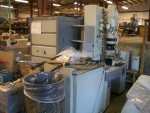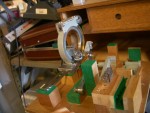Thanks to my OG Detroit upbringing, I've been familiar with Carhartt clothing for a long time. About 5 years ago I started wearing their dungarees (their term for "work pants") because they fit me better, were a classic design and put me in closer touch with my internal frustrated proletarian laborer. Plus, they look badass. In the US, they're still workers' clothing for the most part: farmers, mechanics, welders, and (in much smaller quantities) greasy Burning Man artists. But in Europe, they've become super chic techno clothing, the physical manifestation of a Roland 303 bassline (all the more appropriate since Carhartt is a Detroit brand, and Detroit's place in the techno mythology of Berlin is huge). After noticing that a lot of their clothing was being shipped to boutiques in Europe and Japan and that it was used as the official hoodie for the last Tricky tour, it looks like someone at Carhartt figured it out and decided to license the name.
Now, knowing that, check out the differences in experience in these two sites:
There's even a boutique in one of the hippest parts of Berlin, complete with graffiti and a Carhartt-branded trick bicycle in the window. Many of my friends there wear Carhartt clothing, but it's nothing like the clothing that the US brand makes.
At first, this seems to be good branding strategy: capitalize on reputation in a market that doesn't provide a lot of revenue by licensing your name to a local. It certainly makes more sense than calling your mayo different names depending on which side of the Mississippi it's being sold on (cf: Hellman's vs. Best Foods; also King Dons vs. Ding Dongs, and snicker if you want to).
Now here's the problem: with such a radical difference, is Carhartt endangering their brand? The coolness of the European brand depends on the stodgy solidity of the US brand, since it's based totally on reference and myth, but the US brand is the bread and butter of the company. Say the European licensee does something stupid, like make a really low-quality product (how good can that bicycle be?) and their name gets trashed in world media. Is that going to completely cause the house of cards to fall, creating confusion among the cash cow US market? Brand resilience isn't infinite. Moreover, fashion being what it is, today's Carhartt is tomorrow's Tommy Gear and next week's Cross Colours. Would being super-duper uncool spill over to the US and if it did, would that be a problem?
I don't know, but it's an interesting question and a good example of brand strategy caught in the wild.







Recent Comments